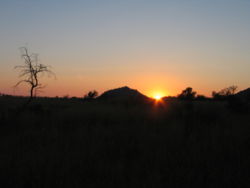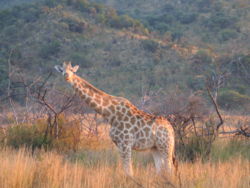| Pilanesberg National Park
Location: North
West Province, South Africa
Nearest city: Sun
City, South Africa
Area: 572 km²
Established: 1979
Governing body:
North West Parks Board
The Pilanesberg National
Park is located in North West Province in South Africa, west of Pretoria.
The park borders with the entertainment complex Sun City. The park was
originally owned by three local tribes, and now by the north west parks
board. This leads to confusion regularly as it is expected that the park
is managed by the South African governments National Park Service as almost
all other national parks in South Africa are.
The area is fringed by three
concentric ridges or rings of hills, of which the formation rises from
the surrounding plains, this is the parks primary geological feature named
the Pilanesberg National Park Alkaline Ring Complex. This vast circular
geological feature is ancient even by geological standards as it is the
crater of a long extinct volcano and the result of eruptions some 1,200
million years ago. It is one of the largest volcanic complexes of its type
in the world, the rare rock types and formations make it a unique geological
feature. A number of rare minerals occur in the park. Pilanesberg National
Park rates high amongst the world's outstanding geological phenomena
Scattered throughout the
park are various sites that originate from the Iron age and Stone age and
show the presence of man from those periods in these areas.
The park
 The
park has an area of 572 km², making it the fourth largest National
Park in South Africa. You can travel through in a standard road vehicle
as although the 200 kilometres of track are not surfaced, they are well
maintained. There are several camps serving the park from the outside,
including Kwa Maritane and Manyane, and several stops on the inside where
there are bars and gift shops. Towards the centre of the park there is
an artificially constructed lake, the Mankwe Dam, and Thabayadiotso, which
means "the Proud Mountain". The
park has an area of 572 km², making it the fourth largest National
Park in South Africa. You can travel through in a standard road vehicle
as although the 200 kilometres of track are not surfaced, they are well
maintained. There are several camps serving the park from the outside,
including Kwa Maritane and Manyane, and several stops on the inside where
there are bars and gift shops. Towards the centre of the park there is
an artificially constructed lake, the Mankwe Dam, and Thabayadiotso, which
means "the Proud Mountain".
Flora and fauna
Plants
The scenic terrain lies in
the transition zone between Kalahari and Lowveld, and both types of vegetation
are found here. As a result of the park being on a trasition zone there
are overlaps in mammals, birds and vegetation. Today, Pilanesberg National
Park accommodates almost every mammal of southern Africa
Mammals
The park has a rich array
of southern african Wildlife including the Big Five, the five most dangerous
game animals in Africa. In the Pilanesberg National Park today live most
of the animal species of southern Africa these include lions, elephants,
white and black rhinos, buffaloes, leopards, zebras, hyenas, giraffes,
hippos and crocodiles. Over 300 bird species were counted. All of the Big
Five can be found here. The Pilanesberg is not in a location which the
Big Five animals would naturally inhabit, however they have been brought
into the 550 square kilometres of african bushland.
As of August 2004 the total
count of animals was approximately 10,000 including:
-
42 Lions (plus 32 month old
cubs)
-
12 Cheetah
-
167 Elephant
-
90 Black Rhino
-
300 White Rhino
-
40 Sable
-
80 Buffalo
 The
only indigenous southern african mammals that are not there are - bontebok,
blesbuck, spotted hyena, nyala and roan. The
only indigenous southern african mammals that are not there are - bontebok,
blesbuck, spotted hyena, nyala and roan.
Birdlife
The Bird life diversity is
excellent with over 300 species having been recorded. Though some are migrants,
most others are permanent inhabitants. Their food sources vary with some
eating carrion or live prey, others eat seeds, fruit or tiny water organisms.
There is a self-guided trail
in the Walking Area at the Manyane Complex in the east, which offers environmental
education whilst game viewing and bird watching on foot. Also at Manyane
there is a walk-in aviary with over 80 species of indigenous birds.
History
Pre 1970s
In the last century, Pilansberg
served as a vary different kind of sanctuary to Mzilikaziís rebel Zulu
warriors passed through the area as they fled the wrath of Zulu king, Shaka.
During the Second Boer War, not long after this, General Christiaan de
Wetís hid from the British amongst these same hills - perhaps promoting
the later purchase of a farm in the area by South African Prime minister
Jan Smuts.
1970s
During the late 1970s, President
Lucas Mangope of Bophuthatswana decided to re-introduce wildlife and turn
the Pilansburg into a game reserve. With Bophuthatswana having been an
independent homeland, the Park was proclaimed by the then local black government.
The 52 cattle farmer in the area were bought out and moved to new homes
elsewhere. The town of Pilanesberg was flattened and all that remains is
the old Magistrates Court which is now called the Pilanesberg Centre. There
is a little restaurant there with a stunning view. After this work began
on Operation Genesis, which involved the game-fencing of the entire reserve
and the re-introduction of long vanished species.
The only other remains is
the small graveyard not visible except for a very short time about 1 in
3 years after controlled burning. The Park was seen as the National Park
of Bophutatswana & of course called Pilanesberg National Park. With
the forceful reoccupation by the old government and the ANC, President
Lucas Mangope was deposed by a coup and Bop reincorporated with South Africa.
Pilanesberg is one of the few names in South Africa that won't change as
it is named after Chief Pilane, a very powerful chief that owns vast land
outside the park. Chief Pilane's grandfather fought with the British against
the Boers and had the reputation of being invisible. It seems that more
land was given for services rendered.
The park was opened in 1979,
as part of the South African Governments Operation Genesis.
1980s
6000 animals were resettled
into the park over the course of the early 1980s with Operation Genesis
which was the largest game resettlement programme in the history of the
country. The 6000 animals were released into the quarrantine area of 10
km² in groups and after a few weeks the fences were dropped. This
is the area now used for elephant back safaris. As the purpose of the park
was a feeder for other parks no lion or cheetah were brought in. However
leopard was naturally present as was brown hyena and mountain reedbuck.
Currently this is The Park in the world that has the highest concentration
of hyena. Also brought in was a family of elephant. As no mature bulls
was brought in as they were too large, the young bulls caused a bit of
havoc and killed 17 rhinoceroses. The reason for this was there was no
parental care and the young bulls came into adolescence at too you an age.
However by this time the transport techniques had improved so 6 older bulls
were brought in from the Kruger. This suppressed the adolescence problem.
The young culprits were all shot.
The creation of the Pilanesberg
National Park is considered one of the most ambitious programmes of its
kind to be undertaken anywhere in the world. The Operation Genesis, which
involved the game-fencing of the reserve and the reintroduction of long-vanished
species, began during the late 1970s. Operation Genesis is still the largest
game translocation undertaken in the world, and as a result the park now
has in excess of 10,000 animals.
1990s
In 1991 Nelson Mandela was
released and all of a sudden tourism took off. So in 1993 the focus changed
and predators were brought in including in 1993 some lions from the Etosha
National Park in Namibia were introduced to the park, despite serious concerns
for the surrounding communities. Since then the lions have been thriving
and nicely multiplying in the park. A similar action with cheetahs from
Namibia unfortunately has had no such success. Camps and lodges were built
on the perimeter and it became a destination.
2000s
The size of the park was
increased from 552 to 572 km² in May 2004 as part of a workable 10
year plan to establish a corridor between Pilanesberg and Madikwe Game
Reserve. The 20 km² that was added on the north western was the first
bit from Pilanesberg's side. On the Madikwe's side there has already been
several additions towards the south east. There are also several private
owners dropping fences from the middle moving towards Pilanesberg and Madikwe.
Property that was 2 years going for R30,000/km² is now selling for
R500,000/km². In the immediate future there concluding plans to have
a huge piece of land to be added to Pilanesberg in the next 2 years. |

